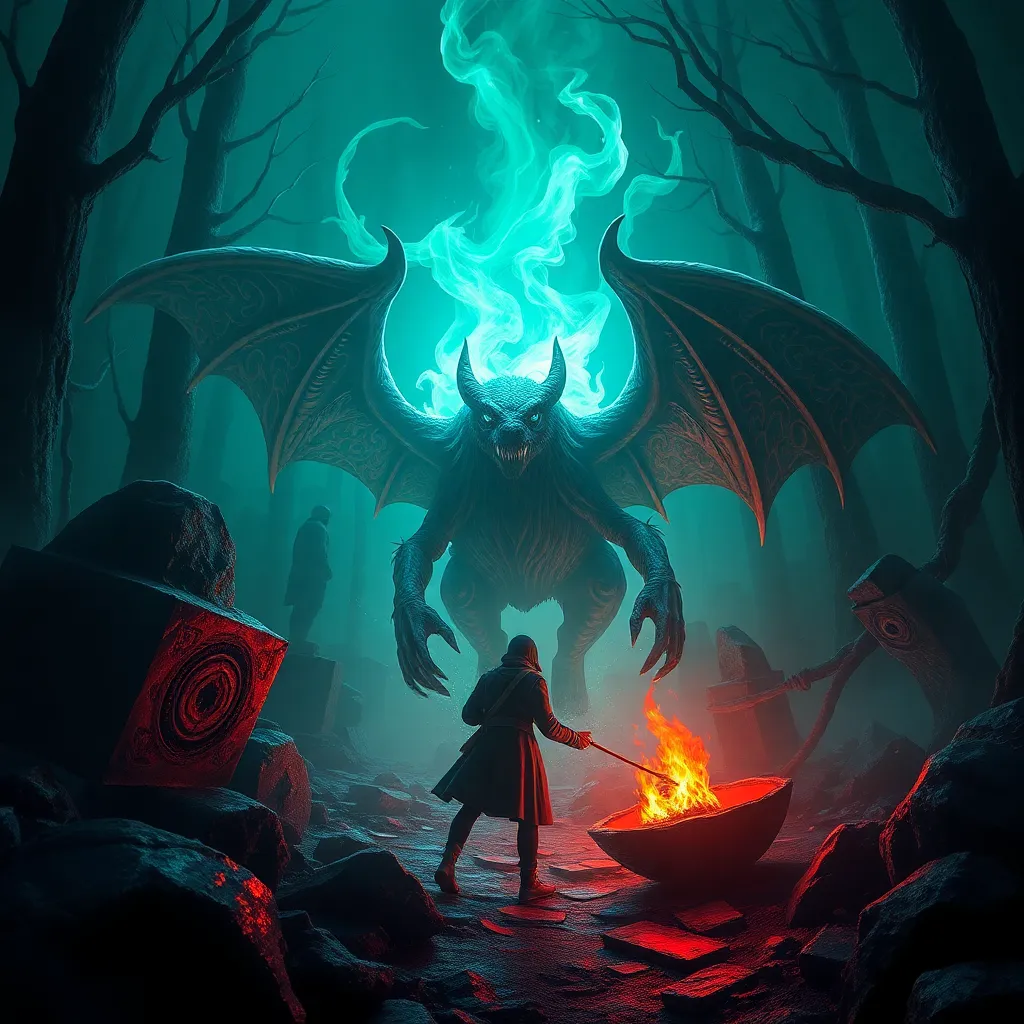The Cyclops in Australian Aboriginal Mythology: Exploring the One-Eyed Giant in Aboriginal Myths
I. Introduction
Aboriginal mythology is a rich tapestry of stories, beliefs, and cultural practices that have been passed down through generations of Indigenous Australians. This mythology is deeply intertwined with the land, nature, and the spiritual world, providing insights into the values and traditions of Aboriginal people. One intriguing figure that appears in various forms across different cultures is the Cyclops, a one-eyed giant that captivates the imagination and symbolizes various elements of human experience.
This article aims to explore the Cyclops figure within Australian Aboriginal mythology, examining its origins, significance, and the lessons encapsulated in these ancient stories. Through this exploration, we can gain a deeper understanding of the cultural context and the enduring relevance of these myths in contemporary society.
II. The Cyclops Archetype in Global Mythology
The Cyclops is not unique to Aboriginal culture; it is also a prominent figure in many other mythologies, most notably in Greek mythology. In these tales, Cyclopes are often depicted as brutish beings with immense strength and a single eye located in the center of their foreheads. They are typically portrayed as both creators and destroyers, embodying the duality of nature.
A. Comparison with Cyclops in Greek mythology
In Greek mythology, the Cyclopes are known for their work in forging powerful weapons for the gods, such as Zeus’ thunderbolts. They are often associated with chaos and violence, particularly in the tale of Odysseus, where the hero encounters the Cyclops Polyphemus, who devours his companions. This narrative highlights the tension between civilization and savagery, a theme that resonates across various cultures.
B. The universal theme of the one-eyed giant
The figure of the one-eyed giant transcends cultural boundaries, often representing themes of power, isolation, and the unknown. In many cultures, the Cyclops embodies the fear of the monstrous and the other, serving as a cautionary tale about hubris and the consequences of underestimating nature’s forces.
C. Role of Cyclops in various cultures
- In Irish mythology, the giant Fomorians are often depicted as one-eyed beings associated with chaos.
- In Hindu mythology, figures like Ravana display characteristics reminiscent of the Cyclops through their immense power and singular vision.
- In Native American legends, there are accounts of similar one-eyed giants that serve as guardians of the natural world.
III. The Cyclops in Aboriginal Stories
In Australian Aboriginal culture, the Cyclops is not as widely recognized as in other mythologies, but variations of this figure exist within certain tribal narratives. These stories vary significantly across different regions and tribes, reflecting the diversity of Aboriginal cultures.
A. Origins and variations of the Cyclops myth in Australian Aboriginal culture
The origins of the Cyclops myth among Aboriginal peoples may be linked to the broader theme of giants in their oral traditions. Some tribes recount stories of a one-eyed giant living in remote areas, often associated with natural phenomena such as storms or earthquakes.
B. Key tribes and regions associated with Cyclops legends
Different Aboriginal tribes across Australia have their own interpretations of the Cyclops myth:
- The Yolngu people of Arnhem Land tell stories of a giant named Gurruṯu, who is described as having a single eye and immense strength.
- In Western Australia, the Noongar people speak of a giant who watches over the land and is both feared and respected.
- Some Central Australian tribes have stories of gigantic beings that embody the spirit of the land, reflecting the Cyclops’ connection to nature.
C. Notable stories featuring the Cyclops
One notable story involves a giant who is said to guard sacred sites, ensuring that only those deemed worthy can access these places. This giant is often depicted as both a protector and a threat, illustrating the duality of nature and the importance of respecting the land.
IV. Symbolism of the Cyclops in Aboriginal Beliefs
The Cyclops figure in Aboriginal mythology carries significant symbolism, reflecting cultural values and beliefs about nature, power, and morality.
A. Interpretation of the Cyclops as a cultural symbol
Many Aboriginal stories use the Cyclops as a symbol of the natural world’s might and unpredictability. The one-eyed giant serves as a reminder of the forces that shape the environment and the need for a respectful relationship with nature.
B. The one-eyed giant as a representation of nature and the environment
The Cyclops can also be seen as a guardian of the land, representing the spirit of the environment that must be honored and protected. This aligns with the Aboriginal worldview, which emphasizes the interconnectedness of all living things.
C. Lessons and morals derived from Cyclops stories
Stories of the Cyclops often impart important morals, such as:
- The necessity of humility in the face of nature’s power.
- The importance of community and cooperation when confronting challenges.
- The value of respecting sacred places and traditions.
V. The Cyclops and the Dreamtime
The Dreamtime, or Tjukurpa, is a foundational aspect of Aboriginal spirituality, encompassing creation stories and the ancestral beings that shaped the world. The Cyclops figure can be linked to Dreamtime narratives, illustrating the connection between these giants and the creation of the landscape.
A. Connection between the Cyclops and Dreamtime narratives
In some Dreamtime stories, the Cyclops is depicted as a creator being, shaping the land and its features. This connection emphasizes the belief that all aspects of the natural world are imbued with spiritual significance.
B. The role of the Cyclops in creation stories
The Cyclops often plays a role in creation myths, where it is said to have carved mountains and valleys, leaving its mark on the earth. These tales reflect the deep respect Aboriginal cultures have for the land and the forces that govern it.
C. The significance of Dreamtime in understanding Aboriginal spirituality
Understanding the Cyclops in the context of Dreamtime helps illuminate the broader spiritual beliefs of Aboriginal peoples, highlighting their connection to the land, ancestors, and the cyclical nature of life.
VI. Contemporary Interpretations and Representations
In recent years, there has been a resurgence of interest in Aboriginal myths, including those featuring the Cyclops. Contemporary artists and writers have begun to reinterpret these stories in various mediums.
A. Modern retellings of Cyclops myths in literature and art
Many modern Aboriginal authors are weaving traditional myths, including Cyclops narratives, into their storytelling. These retellings often incorporate contemporary themes and perspectives, making the stories accessible to new audiences.
B. The influence of Cyclops stories in contemporary Aboriginal culture
The enduring presence of Cyclops stories in modern Aboriginal culture illustrates their significance in maintaining cultural identity and heritage. These tales continue to inspire new generations to engage with their history and beliefs.
C. The impact of globalization on the preservation of these myths
While globalization poses challenges to the preservation of Aboriginal myths, it also offers opportunities for cross-cultural exchange. Increased visibility of Cyclops stories in global media can foster greater appreciation and respect for Aboriginal culture.
VII. Challenges in Understanding Aboriginal Myths
Understanding Aboriginal myths, including those featuring the Cyclops, requires sensitivity and respect for their cultural context. There are several challenges in this area.
A. Issues of cultural appropriation and misinterpretation
As Aboriginal stories gain popularity, there is a risk of cultural appropriation, where outsiders may distort or misinterpret these narratives for commercial gain. This can undermine the original meanings and significance of the myths.
B. The importance of context in understanding mythology
To truly appreciate Aboriginal myths, one must consider the cultural, historical, and spiritual contexts in which they arise. This understanding is crucial for respecting the values and beliefs of Indigenous peoples.
C. Efforts to preserve and respect Aboriginal narratives
Many Aboriginal communities are actively working to preserve their narratives and ensure that they are shared in ways that honor their origins. This includes educating younger generations and engaging with broader audiences through respectful storytelling.
VIII. Conclusion
The Cyclops figure in Australian Aboriginal mythology offers a fascinating glimpse into the cultural beliefs and values of Indigenous Australians. Through stories of the one-eyed giant, we can explore themes of nature, power, and morality that resonate across time and place.
As we engage with these myths, it is essential to recognize their ongoing relevance




